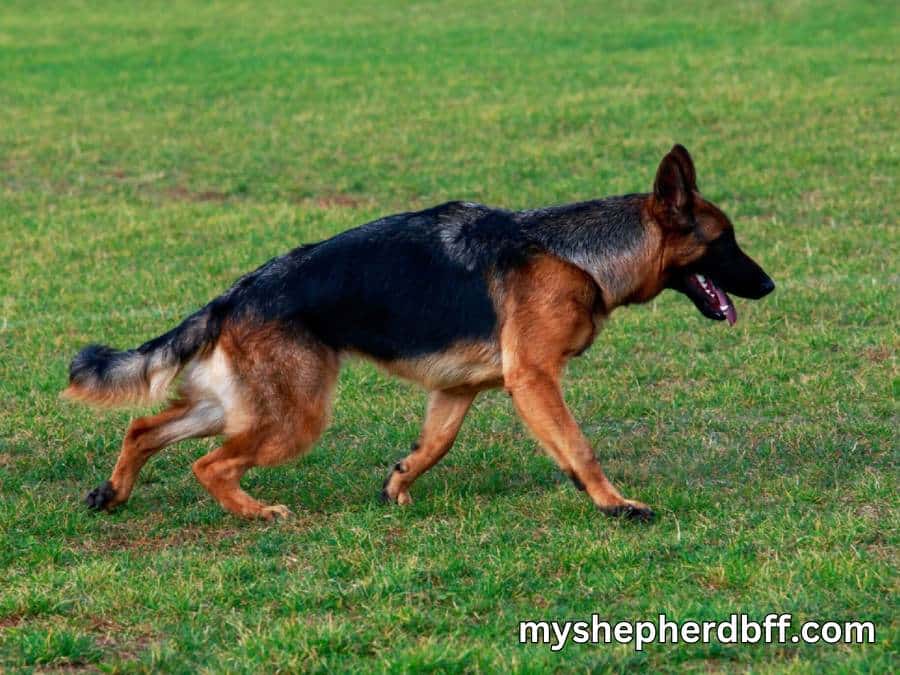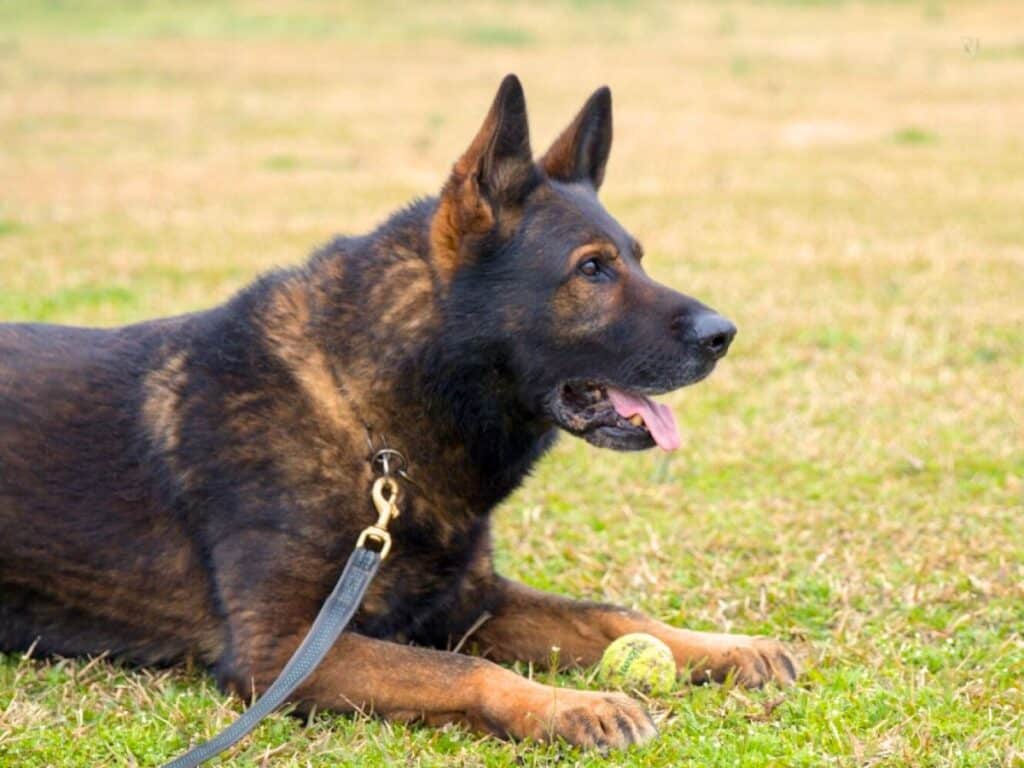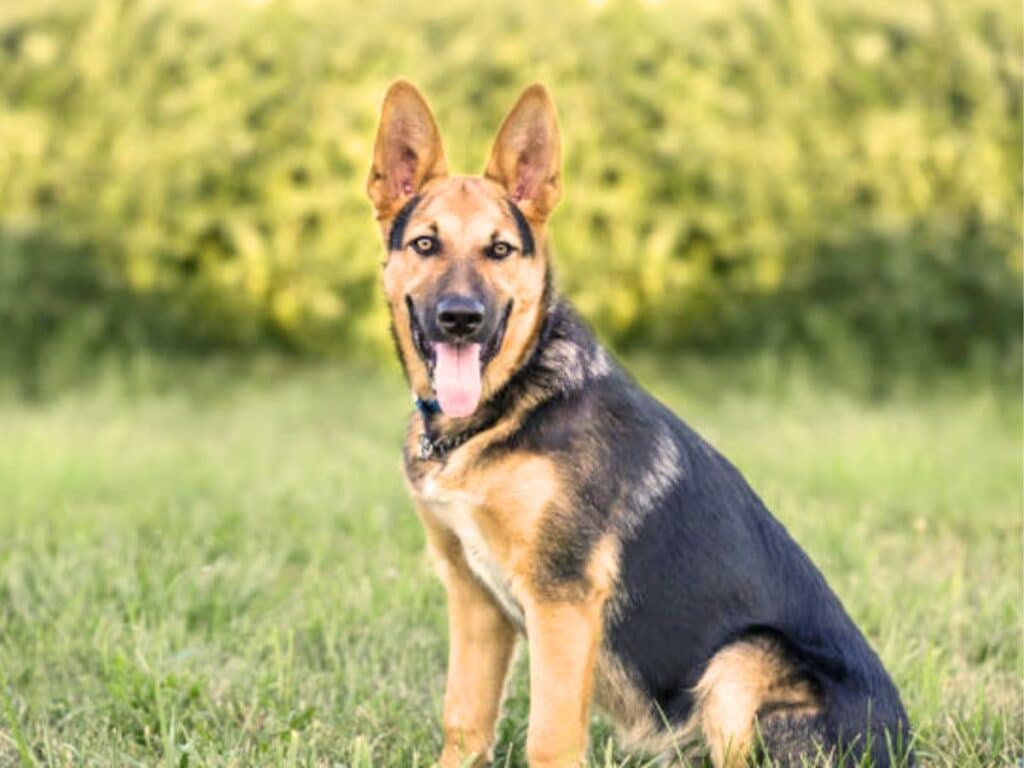A German Shepherd’s powerful back legs effortlessly propelling him across an open field is a sight to behold. But what happens when those back legs start to weaken or become unstable?
As a proud owner of three German Shepherds myself, I’ve experienced the challenges that come with this issue firsthand.
Strong back legs are crucial for German Shepherds. They not only support their overall mobility but also play a vital role in maintaining their posture and gait.
So, if you’re looking to enhance your shepherd dog’s quality of life by bolstering their back legs, let’s dive right into it!
Tips To Make German Shepherd Back Legs Stronger
To ensure that your German Shepherd has strong back legs, there are several effective exercises and strategies you can incorporate into their routine.
1. Exercises and activities for strengthening GSD’s back legs
Regular exercise is essential for strengthening your German Shepherd’s back legs. Here are some exercises and activities you can incorporate into their routine:
- Daily walks: Take your German Shepherd on regular walks to provide them with low-impact exercise that helps strengthen their leg muscles.
- Hind leg stands: Encourage your dog to stand on their hind legs by using treats or toys as motivation. This exercise helps build strength in their back legs.
- Incline walk on hills: Find a hilly area where you can take your dog for walks. Walking uphill engages the muscles in their hind legs, promoting strength and endurance.
- Stair climbs: Encourage your German Shepherd to climb stairs regularly, which helps strengthen the muscles in their back legs.
- Swimming or wading: If possible, introduce swimming or wading sessions for your dog. These activities provide excellent low-impact workouts that engage all muscle groups.
RELATED: German Shepherd Health Issues
2. Provide your dog with a proper high-quality diet

A well-balanced diet provides the necessary nutrients, vitamins, and minerals to support muscle development, joint health, and overall vitality. Here are some key considerations for providing a high-quality diet to help strengthen your German Shepherd’s back legs:
- Protein: Protein is essential for muscle growth and maintenance. Look for dog food with real meat as the primary ingredient. Chicken, beef, and fish are common protein sources in quality dog foods.
- Fat: Omega-3 and Omega-6 fatty acids are particularly beneficial for joint health and reducing inflammation. Look for dog food that contains these essential fatty acids, often sourced from fish oil or flaxseed.
- Carbohydrates: High-quality dog food should include complex carbohydrates like sweet potatoes, brown rice, and whole grains. Avoid foods with excessive fillers and low-quality grains like corn.
- Calcium and Phosphorus: An appropriate balance of calcium and phosphorus is essential to prevent orthopedic issues in large breeds like German Shepherds. Ensure your dog’s food meets these requirements.
- Antioxidants: Antioxidants like vitamins C and E help reduce inflammation and protect the joints. Look for dog foods that incorporate natural sources of antioxidants.
Remember that overfeeding can lead to obesity, which puts additional strain on your dog’s joints, including their back legs. Follow the feeding guidelines on the dog food packaging and adjust portion sizes based on your dog’s activity level and age.
RELATED: German Shepherd Feeding Chart
3. Give your GSD mobility supplements for their joints

Mobility supplements for joints can be beneficial for German Shepherds, especially as they age or if they have a history of joint issues. These supplements can help maintain joint health, reduce inflammation, and support stronger back legs.
- Glucosamine: Glucosamine is a natural compound that plays a vital role in building and maintaining healthy cartilage in joints. It can help reduce joint pain and inflammation. Glucosamine supplements are commonly used to support joint health in dogs. They come in various forms, such as chewable tablets, capsules, or liquid.
- Chondroitin: Chondroitin is often used in combination with glucosamine. It helps maintain the structural integrity of cartilage and may slow down the progression of joint-related issues. Many joint supplements for dogs contain both glucosamine and chondroitin.
- Omega-3 fatty acids: Omega-3 fatty acids, typically sourced from fish oil, have anti-inflammatory properties and can help reduce joint inflammation and pain. These fatty acids are essential for maintaining joint health and overall mobility.
- MSM (Methylsulfonylmethane): MSM is a natural sulfur compound that can help reduce joint pain and inflammation. It is often included in joint supplements for its potential benefits in improving joint function.
- Turmeric: Turmeric contains curcumin, a natural anti-inflammatory compound. Some dog joint supplements include turmeric as an ingredient to help reduce joint pain and inflammation.
- Hyaluronic acid: Hyaluronic acid is a component of synovial fluid, which lubricates the joints. It’s used in some joint supplements to help improve joint mobility and reduce friction.
- Green-lipped mussel extract: This natural supplement contains compounds that have anti-inflammatory properties and can help support joint health.
- Vitamins and Minerals: Some joint supplements also include vitamins and minerals like vitamin C and manganese, which are essential for the formation of connective tissues and maintaining healthy joints.
4. Maintain a healthy weight
Obesity puts extra strain on a dog’s joints, including the back legs. It is important to manage your German Shepherd’s weight to prevent excessive stress on their legs.
Maintaining a healthy weight not only promotes stronger back legs but also reduces the risk of various health issues such as arthritis and heart problems.
It’s important to work closely with your veterinarian to develop a weight management plan that’s suitable for your German Shepherd, taking into consideration their unique needs and any existing health concerns.
RELATED: Why Is My German Shepherd So Skinny?
5. Consider physiotherapy for your furry friend
Physiotherapy and regular massage can be effective ways to help strengthen the back legs of your pup, especially if they are recovering from an injury, dealing with muscle stiffness, or experiencing mobility issues.

- Professional guidance: It’s essential to consult a veterinarian or a canine physical therapist who specializes in rehabilitation. They can assess your dog’s condition and design a customized physiotherapy plan.
- Therapeutic exercises: The physical therapist will prescribe specific exercises to target the muscles in your dog’s back legs. These exercises may include stretching, range of motion exercises, and resistance training to build strength.
- Hydrotherapy: Under the guidance of a professional, hydrotherapy can be highly beneficial. Water provides buoyancy, reducing the impact on joints and enabling your dog to exercise more effectively.
- Modalities: Physical therapists may use modalities like laser therapy, ultrasound, or electrical stimulation to alleviate pain and promote healing in the back legs.
- Home exercises: In many cases, the physical therapist will teach you exercises that you can perform at home to continue the therapy and strengthen your dog’s back legs.
RELATED: German Shepherd Elbow Dysplasia: Symptoms & Treatment
6. Give them a regular massage
Regular massages can help improve blood circulation, reduce muscle tension, and promote overall mobility in your German Shepherd’s back legs. Learn some basic massage techniques or consult a professional animal physiotherapist for guidance.

Consider seeking the services of a certified canine massage therapist who is trained in working with dogs. They will know the right techniques and pressure points to target.
7. Consider modern treatments
In addition to traditional methods, modern treatments can also aid in strengthening your German Shepherd’s back legs. These may include:
- Acupuncture therapy: This ancient practice involves inserting thin needles into specific points of the body to stimulate healing and alleviate pain.
- Veterinary laser therapy: Laser therapy uses low-level lasers to promote tissue repair, reduce inflammation, and relieve pain.
- Chiropractic therapy: A trained veterinary chiropractor can perform adjustments that align the spine and improve overall mobility.
8. Protect your dog from injuries
To protect your German Shepherd from injuries and maintain the strength of their back legs, it’s essential to take several precautions.
Firstly, supervise their play and exercise to prevent risky behaviors and avoid high-impact activities. A proper warm-up and cool-down are essential before and after exercise to reduce the risk of muscle strains.
Leash control during walks and outings can prevent sudden movements and collisions. Protect your dog from slippery surfaces, both indoors and outdoors, and use non-slip mats where needed.
9. Disease management
Disease management for your dog’s back legs is a comprehensive approach that involves collaboration with your veterinarian to address specific musculoskeletal conditions.
It typically includes the use of medications to manage pain and inflammation, physical therapy to improve muscle strength and mobility, and dietary supplements to support joint health.
Weight management is crucial, as excess weight can exacerbate the condition and weaken the back legs.
Regular veterinary checkups help monitor progress and make necessary adjustments to the treatment plan.
Assistive devices, such as braces and mobility aids, may be recommended for more severe cases.
Additionally, lifestyle modifications, adaptive exercise, and emotional support all contribute to improving your dog’s quality of life while managing the condition.
What Causes A German Shepherd To Have Weak Back Legs?
There are several factors that can contribute to the weakness in their hind legs, and understanding the causes can help you better care for your furry friend. Here are some common reasons why German Shepherds may develop weak back legs:
1. Genetic predisposition
German Shepherds are prone to certain genetic conditions that can affect their hind legs. One such condition is hip dysplasia, where the hip joint doesn’t develop properly, leading to instability and weakness.
Another genetic condition is degenerative myelopathy, a progressive disease that affects the spinal cord and can result in hind leg weakness.
Another degenerative condition is intervertebral disc disease (IVDD), which affects the discs between the vertebrae in the spine.
When these discs become damaged or herniated, they can put pressure on the spinal cord, leading to weakness or even paralysis in the hind legs.
Also, certain genetic mutations can lead to conditions like osteochondritis dissecans (OCD), where cartilage in the joints fails to develop correctly. This can result in joint pain, lameness, and weakness in the hind legs.
2. Injury or trauma

Just like humans, dogs can experience injuries or trauma that can affect their mobility. German Shepherds are an active breed, and activities like jumping, running, or playing rough can lead to strains, sprains, or even fractures in their hind legs. These injuries can cause weakness and pain.
3. Age-related Issues
As German Shepherds age, they become more susceptible to age-related conditions that can impact their hind legs.
Arthritis, for example, is a common condition in older dogs that causes inflammation and stiffness in the joints, making it difficult for them to move around comfortably.
4. Obesity
Excess weight puts additional strain on a dog’s joints, including the hips and knees. German Shepherds are prone to obesity if not properly exercised and fed a balanced diet.
The extra weight can contribute to weak back legs and increase the risk of developing other joint-related issues.
5. Neurological disorders
Certain neurological disorders can affect a German Shepherd’s hind legs. For instance, spinal cord compression or nerve damage can lead to weakness, loss of coordination, and difficulty walking. These conditions may require medical intervention to manage and improve the dog’s mobility.
6. Poor nutrition
Poor nutrition can lead to weak back legs in dogs by affecting multiple aspects of their musculoskeletal and overall health. Inadequate nutrition can result in muscle atrophy, joint problems, and weakened bones.
Nutrient deficiencies can impact ligaments, tendons, and even the nervous system, affecting coordination and leg strength.
It’s important to note that these are just some of the possible causes of weak back legs in German Shepherds. If you notice any signs of hind leg weakness in your dog, it’s crucial to consult with a veterinarian for a proper diagnosis and appropriate treatment plan.
What are the Signs Your Dog Has Weak Hind Legs?

If you have a German Shepherd and suspect that they may be experiencing weakness in their hind legs, it’s important to be aware of the signs and symptoms.
1. Difficulty standing up
One of the first signs of hind leg weakness is when your German Shepherd has trouble getting up from a sitting or lying position. They may struggle to put weight on their hind legs and may need assistance to stand.
2. Unsteady gait
Weak hind legs can cause your German Shepherd to have an unsteady or wobbly gait. They may appear to be walking on their tiptoes or dragging their hind legs as they move.
3. Loss of coordination
Hind leg weakness can also lead to a loss of coordination in your German Shepherd. They may stumble or fall more frequently, and their movements may be jerky or uncontrolled.
4. Muscle atrophy
Over time, hind leg weakness can cause the muscles in your German Shepherd’s hind legs to become weaker and smaller. This can be visually noticeable, with a decrease in muscle mass and tone.
5. Difficulty climbing stairs or jumping
As hind leg weakness progresses, your German Shepherd may have difficulty climbing stairs or jumping onto furniture. They may hesitate or struggle to perform these actions that were once easy for them.
6. Incontinence
In some cases, hind leg weakness can also lead to urinary or fecal incontinence in German Shepherds. This can be a result of the weakness affecting the muscles responsible for controlling bladder and bowel movements.
7. Pain or discomfort
Your German Shepherd may show signs of pain or discomfort associated with their hind leg weakness. They may whine, yelp, or show signs of distress when moving or being touched in the affected area.
If you notice any of these symptoms in your German Shepherd, it’s important to consult with a veterinarian for a proper diagnosis and treatment plan.
Why Do German Shepherd Back Legs Need To Be Stronger?
German Shepherds are known for their athleticism and agility. One key aspect that sets them apart is their strong back legs.

These powerful hind limbs play a crucial role in the overall functionality and performance of the breed. Let’s dive into why German Shepherds require stronger back legs:
1. Support for daily activities
Having strong back legs is essential for German Shepherds to perform everyday tasks such as walking, running, and jumping. With stronger back legs, German Shepherds can move with ease and confidence, allowing them to engage in various physical exercises and playtime activities.
2. Enhanced mobility and speed
German Shepherds are often used in various working roles, such as police and military work, search and rescue operations, and competitive sports like agility and obedience trials.
To excel in these activities, they need to be able to move quickly and efficiently. Strong back legs provide the necessary propulsion and drive for the breed to achieve high speeds and cover ground rapidly.
3. Jumping and leaping abilities
Whether it’s scaling obstacles, clearing fences, or leaping across gaps, these dogs need powerful hind limbs to generate the force required for vertical and horizontal propulsion.
Their robust back legs allow them to perform these actions effortlessly, making them exceptional in activities like dock diving and Schutzhund.
4. Support and stability
German Shepherds are large and muscular dogs, and their back legs provide the foundation for their stability and support. The strength in their hind limbs helps them maintain balance and prevent injuries during rigorous physical activities.
Whether it’s running, climbing, or engaging in strenuous tasks, their strong back legs ensure they can handle the demands placed on their bodies.
5. Endurance and stamina

Strong back legs contribute to their overall endurance by allowing them to sustain prolonged physical exertion.
The muscles in their hind limbs provide the necessary strength and power to keep going even during long hours of intense activity.
6. Injury prevention
The muscles, tendons, and ligaments in the hind limbs act as shock absorbers, reducing the impact on the joints and spine. This helps minimize the risk of strains, sprains, and other musculoskeletal issues that can occur during high-impact activities.
Conclusion
By understanding hind leg weakness, recognizing the symptoms, and incorporating exercises and preventive measures, you are taking proactive steps towards ensuring your furry friend’s overall health and well-being. Remember, a strong foundation in the hind legs is crucial for your German Shepherd’s mobility and quality of life.
Now that you have learned how to make your German Shepherd’s back legs stronger, it’s time to put this knowledge into action. So go ahead, grab that leash, and embark on this journey towards healthier back legs for your beloved German Shepherd!
Frequently Asked Questions (FAQs)
1. How can I make my German Shepherd’s back legs stronger?
You can strengthen your German Shepherd’s back legs through regular exercise, which includes activities like walking, running, and swimming. Additionally, consult with a veterinarian or a canine physical therapist for specific exercises and dietary recommendations to support their leg strength.
2. Are there specific foods that can help improve my German Shepherd’s back leg strength?
Yes, providing a high-quality diet rich in protein, essential fatty acids, and joint-supporting nutrients can contribute to stronger back legs. Your veterinarian can recommend suitable foods or supplements to enhance your dog’s muscle and joint health.
3. Can I use joint supplements to strengthen my German Shepherd’s back legs?
Yes, joint supplements like glucosamine and chondroitin can help support joint health and may indirectly contribute to stronger back legs by reducing discomfort and inflammation. Consult with your vet to determine the right supplements and dosages for your dog.
4. Are there any exercises I should avoid to prevent injuring my German Shepherd’s back legs?
It’s best to avoid high-impact activities like excessive jumping or running on hard surfaces, as they can strain the back legs. Always be mindful of your dog’s fitness level and age when engaging in any exercise routine.
5. What role does weight management play in strengthening my German Shepherd’s back legs?
Maintaining a healthy weight is crucial, as excess weight can strain the back legs and lead to muscle and joint issues. A balanced diet, portion control, and regular exercise are key components of weight management to help keep your dog’s legs strong and healthy.




